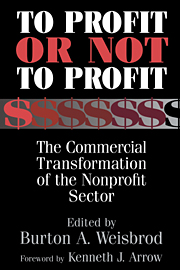Book contents
- Frontmatter
- Contents
- List of contributors
- Foreword by Kenneth J. Arrow
- Preface
- 1 The nonprofit mission and its financing: Growing links between nonprofits and the rest of the economy
- Part I Basic issues and perspective
- Part II Industry studies
- 8 Commercialism in nonprofit hospitals
- 9 Universities as creators and retailers of intellectual property: Life-sciences research and commercial development
- 10 Commercialism in nonprofit social service associations: Its character, significance, and rationale
- 11 Zoos and aquariums
- 12 Commerce and the muse: Are art museums becoming commercial?
- 13 The funding perils of the Corporation for Public Broadcasting
- Part III Overview, conclusions, and public-policy issues
- Appendix: IRS Forms 990 and 990-T for nonprofit organizations
- References
- Index
9 - Universities as creators and retailers of intellectual property: Life-sciences research and commercial development
Published online by Cambridge University Press: 30 November 2009
- Frontmatter
- Contents
- List of contributors
- Foreword by Kenneth J. Arrow
- Preface
- 1 The nonprofit mission and its financing: Growing links between nonprofits and the rest of the economy
- Part I Basic issues and perspective
- Part II Industry studies
- 8 Commercialism in nonprofit hospitals
- 9 Universities as creators and retailers of intellectual property: Life-sciences research and commercial development
- 10 Commercialism in nonprofit social service associations: Its character, significance, and rationale
- 11 Zoos and aquariums
- 12 Commerce and the muse: Are art museums becoming commercial?
- 13 The funding perils of the Corporation for Public Broadcasting
- Part III Overview, conclusions, and public-policy issues
- Appendix: IRS Forms 990 and 990-T for nonprofit organizations
- References
- Index
Summary
Introduction
Over the past decade there has been a remarkable shift in the division of labor among universities, industry, and the federal government. In our view, this transformation is most pronounced in the life sciences and the commercial fields of medicine, Pharmaceuticals, and biotechnology. The post–cold war focus of federal science and technology policy on “competitiveness” has been noted by many observers, and the intensified interest in basic research and collaborative product development by large private corporations in various high-technology fields has been widely studied. However, the accompanying change in the mandate of research universities toward a greater focus on commercializing research findings is much less understood. Our goal in this chapter is to enhance the understanding of the ways in which the relationship between universities and the private economy has changed, particularly in the life sciences. We highlight the primary forces that have blurred the traditionally distinct roles of the academy and industry, illustrating these trends with data from the life sciences. We review several explanations for this transformation, and conclude with a discussion of its consequences both for public policy and for the institutional role of universities as generators and disseminators of basic knowledge.
Throughout much of the post–World War II era there was a relatively clear distinction between basic and applied research, with the former the domain of the university and the latter the turf of business. The federal government, outside of defense-related research, supported the creation of an infrastructure for basic research and, through the National Science Foundation (NSF) and the National Institutes of Health (NIH), funded individual scientists as well.
- Type
- Chapter
- Information
- To Profit or Not to ProfitThe Commercial Transformation of the Nonprofit Sector, pp. 169 - 194Publisher: Cambridge University PressPrint publication year: 1998
- 16
- Cited by



